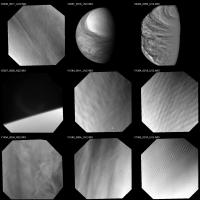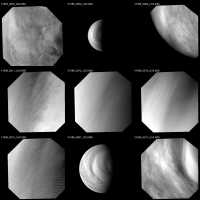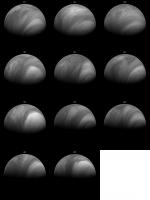Printable Version of Topic
Click here to view this topic in its original format
Unmanned Spaceflight.com _ Venus Express _ Images and Movies of Venus
Posted by: Bjorn Jonsson Jun 10 2012, 11:46 PM
Recently I have been taking a fairly detailed look at the Venus Express (VEX) Venus Monitoring Camera (VMC) data set. Apparently this is a little known data set here at UMSF but this is a really interesting data set that isn't too difficult to process and many of the images show interesting atmospheric features. So without further ado here are some results of my processing efforts, followed by more detailed information below.
Two 3x3 montages of VMC images:
I also assembled a movie from 58 UV images obtained during orbit 1640. It is http://www.youtube.com/watch?v=dmzQWPLoWUc.
A sharpened, tweened version of the movie http://www.youtube.com/watch?v=eINGgQkcXSA.
I selected the montage images to show various types of features and to show interesting stuff: Global views, atmospheric waves, features that appear dark in the UV, a bright south polar band, thermal emission from the surface etc. So far I have taken a quick look at only a few thousand images (maybe about 10,000) but this is a huge data set. I don't know the exact number of images but it is probably more than 100,000. For comparison, Pioneer Venus obtained ~1500 images (I don't know the exact number). VEX has been monitoring Venus continuously for 6 years now and this is a really fascinating data set that seems to be almost unknown among the image processing specialists here. Movies like the one above are relatively easy to make and for anyone interested, it is definitely possible to make hundreds of them if one has the time. Even though the movie above covers a period of just 8 hours this is sufficient to reveal that Venus' atmosphere can change very quickly - significant changes can occur in just a few hours. I haven't done any mosaics yet but I know they are possible. It is probably possible to make atmospheric movies as well. 'Color' composites are possible but not interesting.
Most of the images above are UV images; their name ends with _UV2.IMG. There are also three IR images; their name ends with _N22.IMG. Since I was experimenting, the processing varies from frame to frame in the montages, some of the images have been contrast stretched and some have also been processed with an unsharp mask.
I became interested in knowing more about some of the cloud features visible in the images and managed to relatively quickly find a lot of interesting and useful information, far more than I was expecting - I now almost 400 (!) 'new' pages of stuff to read. Venus is a really interesting planet. Below is a summary of a few things I found interesting but there is a lot more - I haven't read all 400 pages yet ;-).
The VMC observes Venus in four channels: A UV channel, a visible channel and two IR channels. I didn't flat field the images above so some artifacts are visible, especially in the sharpened movie. One problem with the VMC is that the spots and filaments that need to be removed using flat fielding change relatively rapidly so you really need one flatfield image per channel per orbit but this is not always possible. However, images are frequently obtained showing the north polar region at close range and some of these can be used for flat fielding.
One of the IR images shows haze above the limb. The other two IR images appear to show thermal emission from Venus' surface as they appear very dark without any enhancement (night side images).
A few of the images (V1584_0011_UV2, V1584_0015_UV2 and V1585_0010_UV2) show interesting wavy features. The 'waves' were also seen in earlier data but VEX has been able to image them at much higher resolution. Three types have been observed, long straight features, short wave trains and irregular wave fields. The montages above include images of all of these types. The waves are seen in all VMC channels. This means that they are not due to variability in the UV absorber distribution; they are probably caused by variations in the solar illumination angle near the cloud tops. The waves mainly occur in the high north and they may be associated with the Ishtar Terra highland region. This implies a possible orographic origin, i.e. these would then be mountain waves. This is far from certain though, in particular the waves might simply be easier to detect in the north due to the lower solar illumination angle. Interestingly, the VIRTIS instrument which can penetrate deeper in the atmosphere than VMC also detected waves at a greater depth, i.e. in the lower cloud layer.
The variable brightness in the UV images is caused by the presence of an UV absorber. Conversely, there is evidence that the much lower contrast variations in the visible and IR channels are caused by horizontal variations of total cloud opacity. Some features are observed in all filters but the patterns are not totally correlated.
Venus' appearance can change rapidly over a period of a few days. Changes include global brightness, spatial contrasts and the extent of the bright polar band. The polar band boundary varies and sometimes shifts to as low as 30° latitude. In January 2007 the brightness of the south polar region increased by ~30% over a period of four days. One of the montage images (V0267_0018_UV2.IMG) shows the south polar region when this was happening.
In addition to the VMC images, data from VIRTIS (Visible and Infrared Thermal Imaging Spectrometer) might be interesting to process. VIRTIS observes at many wavelengths and is able to penetrate deeper into the atmosphere. Some of the publicly released VIRTIS images show interesting and spectacular atmospheric features.
The VMC data set isn't very difficult to process (IMG2PNG converts the IMGs to PNGs withoout problems) so if anyone does anything interesting with it please post here!
Posted by: tasp Jun 11 2012, 12:47 AM
Great work there, and thanx! Neat planet, tends to be overlooked.
Are images available for comparable spacecraft position/solar angle positions on specific 'dates' in the Venusian 'calendar' ?
I am wondering if we see similar cloud patterns every Venusian 'first day of spring', etc.
Posted by: Bjorn Jonsson Jun 11 2012, 01:00 AM
Yes, they should be available - the Venus Express coverage is almost continuous with only a few gaps in time (but seasonal variations are negligible due to Venus' small axial tilt).
Posted by: jasedm Jun 11 2012, 07:06 AM
Thanks for sharing that Bjorn. I agree with Tasp - Venus doesn't get the attention that other planets do - not quite so photogenic from orbit (unless you have SAR)
Nice to see some of that detail in the clouds.
Posted by: machi Jun 11 2012, 08:40 PM
Nice and interesting images and animations!
"In addition to the VMC images, data from VIRTIS (Visible and Infrared Thermal Imaging Spectrometer) might be interesting to process. VIRTIS observes at many wavelengths and is able to penetrate deeper into the atmosphere. Some of the publicly released VIRTIS images show interesting and spectacular atmospheric features."
Unfortunately, VIRTIS images cannot be opened by "normal" software. ![]()
"Neat planet, tends to be overlooked."
I hope, that Indians and Israelis will send their hi-res SAR orbiter.
BTW, I think, that circular structure in image V1585_0033_N22.img is surface feature. I saw this image somewhere, but I cannot remember where.
Posted by: Bjorn Jonsson Jun 12 2012, 01:15 AM
Here is a sequence of UV images showing how the south polar region changes with time:
The orbit numbers are shown. The sequence includes an image from orbit 267 mentioned in my first post. The big increase in brightness of the south polar band mentioned in that post is obvious. Each orbit is one Earth day.
The images have been sharpened with an unsharp mask. I don't (yet) know the exact image orientation but north is roughly up in the images, probably upper left. The south pole is on the terminator right of center in the images.
EDIT: The subspacecraft latitude is 50 degrees south.
This is a problem and might require some software development but I don't know if/when I'll do something about it.
Posted by: colin_wilson Jun 12 2012, 03:39 PM
The VIRTIS team use IDL (and/or ENVI) software to look at the data. IDL routines to open the data can be freely downloaded from ESA's Planetary Science Archive FTP site at ftp://psa.esac.esa.int/pub/mirror/VENUS-EXPRESS/VIRTIS/VEX-V-VIRTIS-2-3-V2.0/DOCUMENT/ , and documentation about the software and file formats can also be found there.
Unfortunately, IDL is not a free software. The company making it was called RSI, then ITT Vis, and now "Exelis". I know of no free workarounds...
Posted by: JRehling Jun 12 2012, 08:25 PM
Venus doesn't really have seasons. The axis is almost perpendicular to its orbit, which is particularly circular. Venus is on normal behavior all the time. Which is what makes any variation interesting, such as the profound change in SO2 levels observed during Pioneer Venus.
http://www.sciencemag.org/content/223/4640/1072.abstract
Posted by: cndwrld Jun 13 2012, 07:20 AM
If I'm not mistaken, what you have shown are Venus Monitoring Camera (VMC) images. And those are pretty straight forward to open and play with.
Colin_Wilson was saying that the Venus Express imaging spectrometer, called Virtis, has files which are very difficult to open and process. Those are the ones that need the special software. I wish good luck to anyone who wants to get into those.
You picked a nice close-up image. People are having a devil of a time trying to explain all the cloud shapes, and that's a good example.
Posted by: Phil Stooke Jun 13 2012, 11:05 AM
Right - the VIRTIS images are .qub files, image cubes with several layers. I have not looked for file format data so I don't know how the layers are stored - interleaved lines, for example. A Windows/Mac utility that could split an image cube into individual layers would be useful, especially if it could handle several different instruments rather than just VIRTIS.
Phil
Posted by: Bjorn Jonsson Jun 13 2012, 12:13 PM
Some years ago ugordan wrote a utility to read/convert the Cassini VIMS cubes. The VIRTIS data might be comparable to the VIMS data from a 'software/utility' point of view.
Posted by: elakdawalla Jun 13 2012, 03:50 PM
If the VIRTIS data are just band-interleaved or band-sequential, it should, in theory, be possible to open them as raw images in Photoshop.
Posted by: jekbradbury Jun 13 2012, 04:22 PM
This might also help: http://code.google.com/p/virtispy/
Posted by: Bjorn Jonsson Jun 13 2012, 04:31 PM
Thanks - I didn't know about this. At first sight it looks so interesting that I'm about to get convinced that I need to learn Python ASAP.
Posted by: ugordan Jun 13 2012, 05:45 PM
It might, might even be simpler than VIMS cubes. They're mostly just different ways of packing 3D data with occasional extras in certain dimensions.
I'll have to give it a look unless someone else figures out how to read the cubes first. As my interest is primarily in visual channels and Venus is totally bland the motivation factor is somewhat absent. If we were talking about Rosetta VIRTIS Mars and Earth data on the other hand...
Posted by: cndwrld Feb 19 2013, 09:40 AM
Venus Express created a short 12-second movie showing a 24 hour orbit around Venus. It was featured on the VEX Science and Technology page some time ago, and can be seen at:
http://spaceinvideos.esa.int/Videos/2013/01/A_day_in_the_life_of_Venus_Express.
Now you (yes, YOU!) can create your own VEX movies. We've taken several of these 'terminator movies', as we call them. The list of orbits is below, and the data for each one is in the ESA Planetary Science Archive. Anyone can pull out the data and create such movies.
VEX has put together a short instruction manual of how they created the short movie mentioned above. If you'd like to give it a try, go to the FTP site for Venus Express http://www.rssd.esa.int/index.php?project=PSA&page=vex
In the right hand column, under VEX VMC Terminator Movie Cookbook, click on Download to view (and then save) the document. If you have trouble viewing the material, you may wish to read the FAQ file. Users of Chrome browsers, for example, may not be able to access files on the FTP web site due to lack of Chrome support for certain FTP features.
Please use the instructions to go to the Planetary Science Archive and get images for any of the orbits below.
We would love to see some of your images and movies!
Orbits with Terminator Movies
==============================
Listed below are 17 orbits, over three calendar years.
Date Yr-DOY Orbit
======= ==== =====
2010-06-28 10-179 1529
2010-06-29 10-180 1530
2010-06-30 10-181 1531
2010-07-01 10-182 1532
2010-07-02 10-183 1533
2010-07-03 10-184 1534
2010-07-10 10-190 1541
2010-07-11 10-191 1542
2011-02-03 11-034 1749
2011-02-05 11-036 1751
2011-02-06 11-037 1752
2011-02-09 11-040 1755
2011-06-04 11-154 1870
2011-06-05 11-155 1871
2012-01-08 12-008 2088
2012-08-23 12-236 2316
2012-08-24 12-237 2317
Posted by: machi Feb 19 2013, 12:23 PM
Nice summary, thank you! It'll be useful! ![]()
Posted by: nprev Feb 20 2013, 12:16 AM
Nice outreach, Cnd, thanks!!! ![]()
Posted by: Bjorn Jonsson Feb 20 2013, 12:35 AM
Thanks, this is really interesting.
And this is a really interesting dataset that deserves far more attention as I already indicated early in this thread (in fact the first post includes a link to an experimental movie on YouTube that I made from VEx VMC images).
Posted by: Bjorn Jonsson Feb 24 2013, 02:52 AM
http://youtu.be/zdd6lneAD2U.
In contrast to the ESA orbit 2088 movie I used all 290 images obtained during orbit 1749. This means that the time interval between the images is not uniform but this is actually a good thing since this slows the movie down during closest approach when everything happens very fast.
I still haven't figured out how to flat field these images properly and this is visible in parts of the movie (actually this can also be seen in the ESA movie but not as clearly).
Posted by: ElkGroveDan Feb 24 2013, 04:02 AM
Are those all unique images, or do you do some interpolating/morphing?
Posted by: Bjorn Jonsson Feb 24 2013, 12:47 PM
All of the images are VEx images - there is no morphing. The main change from the source images is that I translated some of the images horizontally to make the movie more 'smooth'.
Posted by: cndwrld Feb 25 2013, 02:23 PM
Very cool, Bjorn. That orbit shows the upper atmosphere obsorber really well. This is great.
Posted by: elakdawalla Feb 27 2013, 04:21 AM
Don, I started poking in to this today and am wondering if you can explain to me what the multiple entries in the GEO_VENUS.TAB files mean. There are 25 lines in the table for each image. Some of the metadata is identical (filename, sub solar point, spacecraft altitude, etc) but then there are a whole series of lat/lon, center lat/lon, and phase angle numbers that are different for each of the 25 lines. I assume that this has something to do with quantifying the geometry at specific points in the image but 10 minutes of wandering around the DOCUMENT and INDEX folders didn't result in an explanation for what these things are.
This is, indeed, a large data set, about 150 images per day; I'm trying to figure out a way to come to grips with it. There are browse JPEG thumbnails for every image so it should be possible to make one of my patented browse index pages but first I need to figure out what the salient metadata is. Unfortunately the information on the date that each image was taken is located in a different file from the information on the geometry of each image.
Posted by: cndwrld Feb 27 2013, 09:48 AM
Unfortunately, I can't explain anything about the data format.
The good news is that I know the people who can, in the PSA. The bad news is they are struggling this week to prepare for a meeting; and the meeting is all next week. I'll get your questions to them, and put you in direct contact if needed. And once we get the answers to the questions, we can post them here in case it helps anyone.
But the answer might take a little while, just because of the timing.
In the mean time, I'll run this past another person who might know. Maybe we'll get lucky.
Posted by: elakdawalla Feb 27 2013, 04:49 PM
I'm in no hurry, so I'm happy to wait for the answer to this question! Thanks for relaying it.
Posted by: Bjorn Jonsson Mar 4 2013, 12:29 PM
I agree that more detailed information on the .TAB files would be very useful but I'm also not in a hurry. I'm interested in making mosaics from some of the images where Venus more than fills the field of view but due to the rapidly varying viewing geometry this requires reprojecting the images to a simple cylindrical map. I could use the SPICE stuff for this but if the .TAB files contain the required information (e.g. subspacecraft point/location of subspacecraft point/north azimuth or right ascension/declination/twist) using them is easier in most cases.
Powered by Invision Power Board (http://www.invisionboard.com)
© Invision Power Services (http://www.invisionpower.com)



